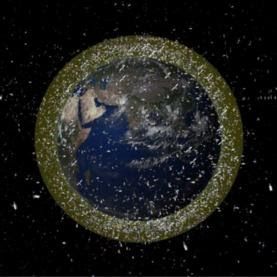
© ESAThis computer simulation depicts
the density of space junk circling the plane
The 'space fence', which is officially known as the US Air Force Space Surveillance System, is going to be shut down on October 1st this year.
The system, which is a multi-station radar, tracks satellites, meteoroids and space debris that is heading our way. The radar stations are scattered across the southern USA and can detect objects some 25,000 miles away from the Earth. The tracking devices form a crucial part of our defenses against all types of space matter likely to cause damage to the planet.
The Congressional sequester imposed automatic budget cuts meaning there just isn't the cash to run the service past October 1st. It's worrying in the extreme that the government thinks it's reasonable to shut down such a critical part of our defense system. As more and more satellites are blasted into orbit from countries around the globe it's not difficult to work out that more and more of them will eventually crash back to Earth.
The way the system works is simple. Satellites are in known orbits, and when they pass over certain points a computer goes 'ping'. If a ping arrives at the wrong time, the orbit has changed for some reason. Often this means that the satellite is damaged or at the end of its life and has (or soon will be) broken up, and/or started its decent back to the planet. The system can track the space junk as it orbits, as well as giving an indication of where the hit may occur.
With meteorites etc. the system is once again alerted by a 'ping' that is unexpected either in time or placement. The object can then be investigated, data analyzed and the threat assessed.
Obviously there are other ways to track space debris, and when it's much farther away, but the space fence is just that: a fence. The inner layer that pinpoints exactly what an item is and where it's going.
Thanks to the irresponsibility of the government, from October 1st we can no longer rely on the warnings of incoming hazards the space fence would have provided.Read More
"Thanks to the irresponsibility of the government, from October 1st we can no longer rely on the warnings of incoming hazards the space fence would have provided."
Rely on the govt? Really? Since when? Or has there been a 2nd Coming of some Christ that I'm unaware of? It's it usually the case that the Feds are 20 to 30 years behind the curve? So the next generation might see some action on this sort of deep space suveillance system... right after the Feds get a budget deal done.... surely we can rely on them to do that, right?